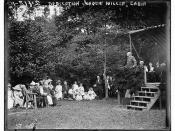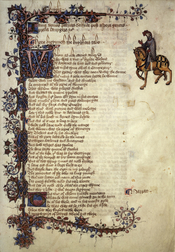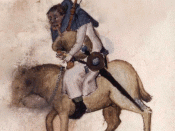Abraham's A Glossary of Literary Terms defines genre as " a term that denotes types or classes of literature."� (Abrams, 108) Chaucer's The Canterbury Tales opens with two tales which fall under contradicting genres. Devotion, duty and honor are the greatest themes flowing through Chaucer's "The Knight's Tale,"� as it is from the genre of Chivalric Romance. It depicts a "courtly chivalric age, often one of highly developed manners."� (Abrams, 35) "The Miller's Tale,"� falls under the genre of the fabliau, "a short satiric tale dealing with middle and lower class characters delighting in the ribald."� Chaucer use of "The Miller's Tale,"� completely contradicts the ideal values expressed by the Knight and as result, Chaucer is able to rewrite the conventions of "The Knights Tale"� and produce new meaning for both tales.
Chaucer's "true, perfect, gentle Knight" (Chaucer, 5) opens the story-telling contest with a romantic tale of fantastical chivalry, devotion, and fortune.
His courtly preoccupation with "truth and honor, liberality, and courtesy" (Chaucer, 5) is exemplified in the noble knights, Arcite and Palamon, and the faultless Lady Emily, whose "complexion vied with the color of roses" (Chaucer.51). "Fortune and her false wheel" (45) control the plot, as regal personas are maneuvered by chance and by the gods. In lofty, long-winded prose, the Knight revels in the established social structure of his time and in the order of the universe, as each character is cared for "according to his rank," (Chaucer.103) and each noble person ultimately gets his wish.
The Knight's scrupulous idealism presents a stark contrast to the Miller's gritty parody of imaginary valor. Similarly framed by a love triangle, the Miller's fabliau glorifies the bawdy cunning of a vulgar clerk. The Miller turns the Knight's elegant world upside-down, mocking religion, ridiculing romance, and contradicting social ideals. The hero is young and immoral. His lady is cruel and unfaithful, and the character that most closely adheres to the Knight's standard of true love and purity is humiliated for his credulousness and lampooned by the entire town. Nicolas, the clerk is punished, not for deceiving his landlord, or for sleeping with Alison, but for foolishly trying the same trick twice. Justice is not delivered by the powers that be, but by the angry, vengeful priest who adopts Nicolas' sly style and beats him at his own game.
The lewd, slang-spattered Miller's tale is a shocking wake-up call after the Knight's florid imagery. Once the Knight has concluded his poetic ramble, Chaucer, as narrator, forewarns the audience that he "must repeat all"ætales, be they better or worse" (Chaucer, 49) and then allows the Miller to cheerfully address parts of the anatomy that don't exist in the knightly saga. Though both use natural metaphors to describe the ladies in question, the Knight evokes a Garden of Eden, while the Miller paints a carnal forest. Emily is at first mistaken for a goddess, her voice "as heavenly as an angel's" (Chaucer, 51) while Alison sings "like a barn swallow", "skittish as a colt" (Chaucer, 153). Palamon's sweetheart is a chaste virgin, but Nicolas' amour is a married woman. The suitors articulate their love characteristically. Arcite pines away in prison for Emily, wailing, "The lively beauty of her who wanders in that place yonder works sudden death upon me; unless I have mercy and favor from her"æI am but dead" (Chaucer 55). Nicolas also moans that death will claim him without his lady, but his desires are purely physical: "Unless I have my will of you, sweetheart, I'm sure to die" (Chaucer, 155) In both the Knight's and the Miller's tales, oaths and promises are made and broken. Upon hearing the plight of the wretched passersby, Theseus "swore"æthat he would"æavenge them upon the tyrant Creon" (Chaucer, 47). Arcite and Palamon are "bound most solemnly by oath" (Chaucer, 55) to respect and love each other as brothers. They later vow undying love for Emily, as well as eternal service to the gods. Arcite promises, "on [his] faith as a knight" (Chaucer, 77) to bring armor to Palamon and fight him to the death. When oaths of brotherhood and love for Emily conflict, the knights abandon their primary persuasion of mutual support and become, just as fervently, "servants of Love" (Chaucer, 85) pawns of Venus and Cupid's arrow. The solemn oaths of the Knight's tale are comically flipped in the Miller's tale, carelessly blurted without the least intention of being kept. Alison makes her oath to Nicholas "By Saint Thomas a Becket, that she would be his to command" (Chaucer, 155) while promising the carpenter that she is his "faithful, true, wedded wife" (Chaucer,169) Extracting John's "word of honor" (Chaucer,169) Nicolas envisions "a wild and furious flood"� but vows to "save [Alison] and [John] and [himself]" (Chaucer165). The Miller ridicules the chivalrous faith in promises, suggesting that, in the mundane world, oaths are misused and broken for more trivial and ignoble purposes than romantic love or kinship.
The tales achieve a certain unanimity in their take on the female gender. The reader is hard-pressed to choose which image is less complimentary: the Knight's depiction of frail, servile, damsels, marrying on command, or the immoral, wicked tease in of Miller's. Theseus' ladies, weep and moan profusely (Chaucer, 83, 85) and are apt to "feel such sorrow"æthat for the most part they mourn thus, or else fall into such sickness that in the end they certainly die" (Chaucer, 132). Emily, the reluctant virgin, has absolutely no desire to wed either of her ardent suitors. When pressed into service, her only conjugal requirement is that she marry the man who "most desires [her]" (Chaucer,109). The carpenter's wench, with her "wanton eyes" (Chaucer 153) while no lady, is no pushover. She breeches the covenant of marriage without a second thought, and cruelly humiliates the wooing Absolom.
As one tale follows the other, Christian virtue is juxtaposed against Machiavellian ruthlessness, presenting an ironic clash between valor and shrewdness. Palamon and his cousin rejoice at the chance to risk their lives for their beloved Emily, while Nicolas prides himself on slyly endangering John's life for a night of pleasure. Though Arcite refuses to harm the unarmed Palamon, crafty Nicolas figuratively stabs his generous host in the back, and delights at the chance to kick Absolom when he's down. While the Knight's gentle rhetoric makes the Miller sound coarse, the Miller's practicality clears the air of pretension left by knightly vows and jousts. Similarly, the end results range from the lofty to the ridiculous. Palamon is rewarded for his undying love with eternal wedded bliss and Arcite tumbles to a gory death after a moment of glory, while on a smaller stage John suffers a hard fall for his naivetÃÂé, Nicolas takes the heat after letting down his guard, and the romantic dandy Absolom learns to open his eyes before leaning in. While the theme of the Miller's tale seems less elaborate than the Knight's, both focus on love and the foibles of humanity. Whether dressed in armor or "a flared apron"(Chaucer,153) all the players are part of the human comedy.
The Knight creates certain conventions in his tale however the Miller utilizaties them in his and makes a complete farce of them through his tale. It is, thus, through "The Miller's Tale"� that Chaucer is able to rewrite all of the idea expressed in that of "The Knight's Tale"� and produce a new idea. That idea being that all the characters expressed in the Knights and Miller's tale including themselves are part of this never ending comedy, that is life.





